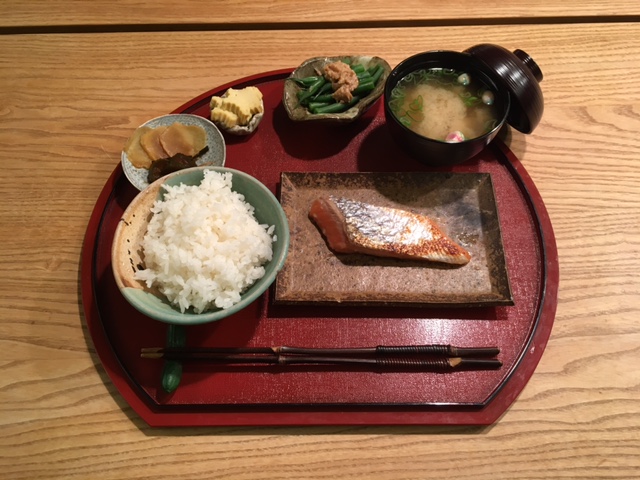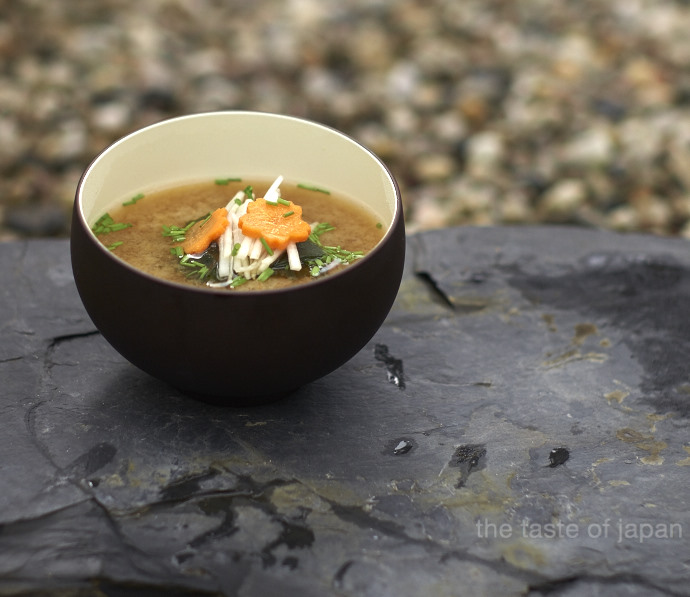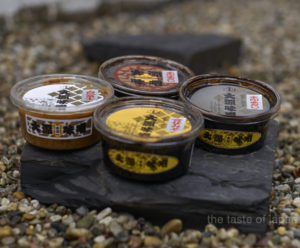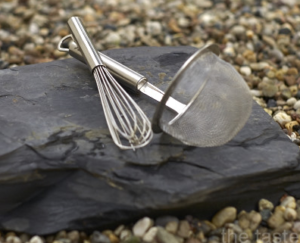A while ago I wrote about ‘one of these days’. Days on which nothing seems to work out or days on which time seems to fly too fast to get everything done – or worse: both. Spending time in the kitchen to prepare your family a healthy, nutritious meal is usually not on top of the list on those days. The focus is more on how to get something quickly on the table that soothes the mind of children, hungry and tired from the day, and switches their mood to ‘satisfied and happy’.
In Japan it is unusual to cook every dish on the same day
Once every week we return home really late. Hungry and tired after a long day that ends with the girl’s swimming lesson. Once at home I only have a few minutes to get dinner on the table, but thanks to the general rhythm in Japanese cuisine this is a doable task. Traditionally a Japanese meal consists of one main dish, two side dishes, a soup and rice. In Japanese referred to as ‘ichi-ju-san-sei’. One-soup-three dishes. An accompanying bowl of rice is not in question, so it is not mentioned. But it is not uncommon that the different dishes are prepared on different days.
Japanese cuisine is extremely seasonal and it is frugal, as you can read in Persimmon Peel Prominence or The Peak of Flavor or Why Wash Rice?. Nothing goes to waste. Typically you find in a Japanese meal something that is in season as well as something that needed to be prepared, left from cooking other dishes. Skillfully organized, it is possible to get a traditional Japanese meal on the table in 10-15 Minutes. Nutritionally balanced, fresh and yummy.
As an example I take our dinner from this week’s swimming-day. On the tray you find:
- String beans with a walnut-miso-sauce,
- pickled cucumber with kombu and ginger as well as some takuan (pickled radish)
- tamagoyaki (rolled omelet),
- miso soup with carrots, green onion tops and little wheat gluten,
- miso marinated salmon and
- rice.
Cooking time in total about 1,5-2 hours, but spread over a couple of days. ‘Cooking’ time to get dinner on the table that night: 10-15 minutes. Mainly ‘that long’, because I wanted to serve the salmon still warm and not at room temperature, which is commonly done in Japan. But how is that possible?
A Japanese 15 minute meal
Not a recipe for a single dish, more a recipe for a rhythm in the kitchen that enables you to get a Japanese meal on the table in 15 minute.
Just before dinner time (right after we get home):
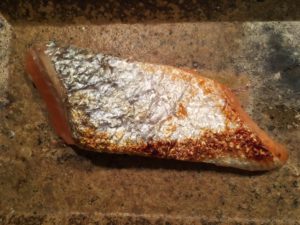
- Take the salmon from the marinade and fry it on medium heat, put dashi in a separate pan and bring to a boil
- While this is happening, take the string beans, miso-sauce, tamagoyaki and pickles out of the fridge and arrange on individual plates
- Cut carrots and green onions and place them with the (store bought) wheat gluten
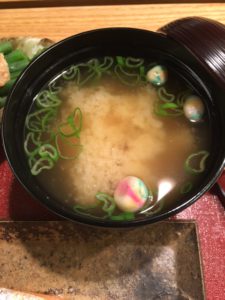
Prep-time for miso soup is basically the time necessary to heat dashi in the soup bowl (my family doesn’t eat cooked carrots, so they go directly in the bowl)
- Plate the salmon
- Take dashi from the heat, add miso and pour into the soup bowl.
- Fill rice bowl with freshly cooked rice. ‘Itadakimasu’ (Enjoy)!
On the days before our dinner
- I cooked the string beans on the day they were bought and stored them in dashi with a dash of soy sauce and a dash of mirin (sake brewed from mochigome – Japanese sweet rice)
- I usually rejuvenate miso that lost its aroma and make some kind of neri miso with it (see basic recipe in What can you do with ‘old’ Miso?) and as such I had a walnut-miso-sauce waiting in my fridge that I made a while ago (probably a week or so).
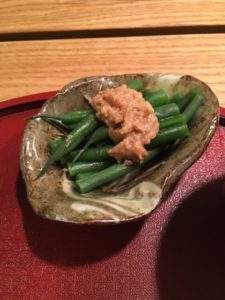
The string beans were cooked and stored in dash the day they were bought - I always make pickles when I come across good looking vegetables at a reasonable price or whenever ‘it is time’ to do something with what I have on hand (like I use left-over kombu) or make persimmon vinegar ). In this case I came across really fresh mini-cucumbers about a week ago, which I like in particular, because they are the closest to Japanese cucumbers that you can get around here. At the same time I had quite an amount of left-over kombu from making dashi. So I pickled them together with ginger, soy, mirin and vinegar.
- The day before our dinner I made Tamagoyaki and whenever I do this I usually make a few omelets. In theory the keep a couple of days in the fridge, but in our home the ‘magically’ disappear quickly….
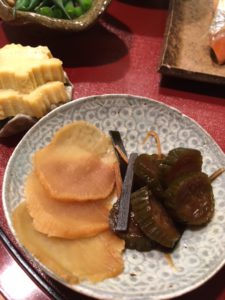
I always have pickles in my fridge that can be pulled out any given time to enhance a meal - In my kitchen dashi for miso soup is basic layout and I always have some in the fridge. Similar I always have a jar of kombu sitting in water on my kitchen counter so I can make new dashi in a couple of minutes (see recipe). As such making miso soup (see recipe here) is a piece of cake.
- The salmon also went in the miso on the weekend before (here is the recipe). Whenever I get my hands on really fresh fish I get a bit more and put it in miso, because it is yummy and because with three kids, a job and a household to manage I can pretty much rely on ‘those days’ to happen. By the way: the technique of preserving fish in miso is an old one and has been invented long before there was refrigeration. So don’t be shy. Give it a try!
- I did not prepare the rice days before. I prepared it in the morning (read here what you need to do and why) and put it in the rice cooker who did the cooking automatically at the time set and we had freshly cooked rice when we got home.
And what are we going to have today? I am not sure yet. There are still some string beans sitting in dashi that could go well with dry roasted katsuo bushi (bonito flakes) and some soy sauce as well as a piece of silken tofu that would make a perfect match as shira aé (tofu sauce) to some of the loquats that I came across the other day and I also have an eggplant that should be used. I could simmer it in neri miso and dashi and finish it off with some roasted sesame seeds. With some rice, a soup and some of the pickles in my fridge we should be set for tonight. Prep time: probably something around 30 minutes…

